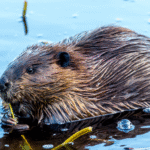In the wild, looking like something you’re not can mean the difference between life and death. That’s why so many animals have evolved the incredible ability to mimic other creatures, plants, or even objects—fooling predators, prey, and sometimes even humans.This survival strategy is called mimicry, and it’s one of nature’s most fascinating tricks. From harmless insects pretending to be deadly snakes to predators disguising themselves as flowers, mimicry shows how clever evolution can be.Let’s explore the different types of animal mimicry—and meet some of the most amazing masters of disguise in the animal kingdom.
1. What Is Mimicry?
Mimicry is when one species evolves to resemble another species or object to gain an advantage—usually for survival or reproduction.There are different types of mimicry, but they all serve one key purpose: deception.
2. Batesian Mimicry: Faking Danger
Named after naturalist Henry Bates, this form of mimicry happens when a harmless species imitates a dangerous or unpalatable one to avoid being eaten.
Classic examples:
- Viceroy butterfly mimicking the toxic monarch butterfly
- Hoverflies and bee-mimicking moths that look like wasps or hornets
- Milk snakes that imitate venomous coral snakes (red touches yellow… yikes!)
Predators learn to avoid the dangerous species—and the mimic gets protection by association.
3. Müllerian Mimicry: Safety in Similarity
In this form, two or more dangerous or unpalatable species evolve to look alike. This reinforces the warning for predators: “Avoid anything that looks like this.”
Example:
- Multiple species of poison dart frogs with bright, colorful patterns.
Even though they’re all toxic, their shared appearance helps educate predators faster.
This is evolution working as a team.
4. Aggressive Mimicry: Predator in Disguise
Not all mimicry is for defense. Some animals use it to lure and deceive their prey.
Wild examples:
- Anglerfish with a glowing lure that looks like prey, attracting curious fish right into its jaws
- Orchid mantises that look like flowers, ambushing pollinators
- Spider-tailed horned vipers whose tails mimic insects to trick birds
It’s like nature’s version of bait and switch—with deadly consequences.
5. Automimicry: Disguising Parts of the Body
Some animals mimic parts of their own body—or even other creatures—using just certain features.
Examples:
- Eyespots on butterfly wings that resemble owl eyes to scare predators
- False heads on the tails of snakes or caterpillars to protect the real head
- Frilled lizards and cobras that make themselves look larger and more threatening
These adaptations can intimidate attackers or redirect bites away from vital areas.
6. Mimicry Between Species: The Art of the Bluff
Some of the most fascinating examples come from unexpected species interactions:
- Cleaner fish mimics that pretend to clean other fish—but actually take bites out of them
- Ant-mimicking spiders that fool predators and even ants themselves
- Caterpillars that mimic bird droppings to avoid attention (yes, really)
These creatures don’t just hide—they pretend. And it works.
7. Mimicry vs. Camouflage: What’s the Difference?
While both are forms of deception, they’re not the same:
| Camouflage | Mimicry |
|---|---|
| Blends in with surroundings | Pretends to be another organism or object |
| Passive hiding | Active deception |
| Examples: chameleons, leaf insects | Examples: milk snakes, orchid mantises |
Some species even combine both for maximum survival advantage.
Final Thoughts: Imitation Is Evolution’s Greatest Flattery
Mimicry is more than just cool biology—it’s a survival masterpiece crafted by millions of years of natural selection.
Whether it’s a butterfly pretending to be poisonous, a spider faking an ant, or a flower-shaped mantis lying in wait, mimicry shows us that in nature, the best strategy isn’t always to fight or flee—it’s to fool. Next time you walk through the woods or look into a tidepool, ask yourself: Is what I’m seeing really what it appears to be?
Because in the wild, things aren’t always as they seem.



